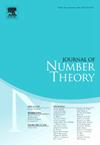归一化近似值的累积点
IF 0.6
3区 数学
Q3 MATHEMATICS
引用次数: 0
摘要
以二阶近似理论的经典方面为基础,我们考虑了具有 α∈Rd 和 q∈Z 的点 qα 的归一化整数向量平移的所有堆积点的集合。在论文的第一部分,我们推导了关于积点都是 Rd 的 α 集合的度量论和豪斯多夫维度结果。在第二部分中,我们主要关注当 α 的坐标与 1 一起构成代数数域 K 的基础时的情况。我们在此证明,在正确的归一化条件下,累积点集合显示出有序的几何结构,它反映了基础数域的代数特性。例如,当 d=2 时,这个积点集合可以被描述为一个椭圆或一对双曲线的扩张(通过 K 中一个阶元素的规范)的可数联合,这取决于 K 是否有一个非三维嵌入到 C 中。本文章由计算机程序翻译,如有差异,请以英文原文为准。
Accumulation points of normalized approximations
Building on classical aspects of the theory of Diophantine approximation, we consider the collection of all accumulation points of normalized integer vector translates of points with and . In the first part of the paper we derive measure theoretic and Hausdorff dimension results about the set of α whose accumulation points are all of . In the second part we focus primarily on the case when the coordinates of α together with 1 form a basis for an algebraic number field K. Here we show that, under the correct normalization, the set of accumulation points displays an ordered geometric structure which reflects algebraic properties of the underlying number field. For example, when , this collection of accumulation points can be described as a countable union of dilates (by norms of elements of an order in K) of a single ellipse, or of a pair of hyperbolas, depending on whether or not K has a non-trivial embedding into .
求助全文
通过发布文献求助,成功后即可免费获取论文全文。
去求助
来源期刊

Journal of Number Theory
数学-数学
CiteScore
1.30
自引率
14.30%
发文量
122
审稿时长
16 weeks
期刊介绍:
The Journal of Number Theory (JNT) features selected research articles that represent the broad spectrum of interest in contemporary number theory and allied areas. A valuable resource for mathematicians, the journal provides an international forum for the publication of original research in this field.
The Journal of Number Theory is encouraging submissions of quality, long articles where most or all of the technical details are included. The journal now considers and welcomes also papers in Computational Number Theory.
Starting in May 2019, JNT will have a new format with 3 sections:
JNT Prime targets (possibly very long with complete proofs) high impact papers. Articles published in this section will be granted 1 year promotional open access.
JNT General Section is for shorter papers. We particularly encourage submission from junior researchers. Every attempt will be made to expedite the review process for such submissions.
Computational JNT . This section aims to provide a forum to disseminate contributions which make significant use of computer calculations to derive novel number theoretic results. There will be an online repository where supplementary codes and data can be stored.
 求助内容:
求助内容: 应助结果提醒方式:
应助结果提醒方式:


